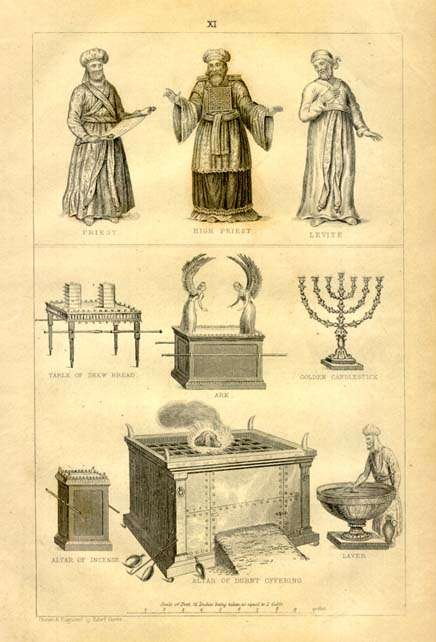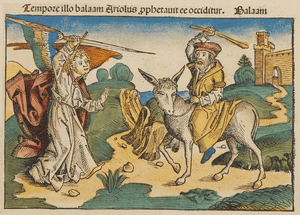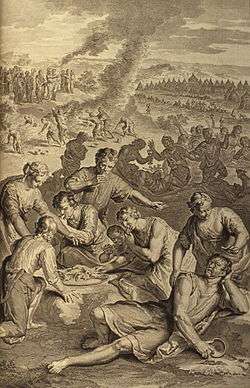Book of Numbers
 | |||||||||||||||||||||||||||||||||||||||||
| Tanakh (Judaism) | |||||||||||||||||||||||||||||||||||||||||
|---|---|---|---|---|---|---|---|---|---|---|---|---|---|---|---|---|---|---|---|---|---|---|---|---|---|---|---|---|---|---|---|---|---|---|---|---|---|---|---|---|---|
|
|||||||||||||||||||||||||||||||||||||||||
| Old Testament (Christianity) | |||||||||||||||||||||||||||||||||||||||||
|
|||||||||||||||||||||||||||||||||||||||||
| Bible portal | |||||||||||||||||||||||||||||||||||||||||
The Book of Numbers (from Greek Ἀριθμοί, Arithmoi; Hebrew: בְּמִדְבַּר, Bəmiḏbar, "In the desert [of]") is the fourth book of the Hebrew Bible, and the fourth of five books of the Jewish Torah.[1] The book has a long and complex history, but its final form is probably due to a Priestly redaction (i.e., editing) of a Yahwistic source made some time in the early Persian period (5th century BCE).[2] The name of the book comes from the two censuses taken of the Israelites.
Numbers begins at Mount Sinai, where the Israelites have received their laws and covenant from God and God has taken up residence among them in the sanctuary.[3] The task before them is to take possession of the Promised Land. The people are counted and preparations are made for resuming their march. The Israelites begin the journey, but they "murmur" at the hardships along the way, and about the authority of Moses and Aaron. For these acts, God destroys approximately 15,000 of them through various means. They arrive at the borders of Canaan and send spies into the land. Upon hearing the spies' fearful report concerning the conditions in Canaan, the Israelites refuse to take possession of it. God condemns them to death in the wilderness until a new generation can grow up and carry out the task. The book ends with the new generation of Israelites in the Plain of Moab ready for the crossing of the Jordan River.[4]
Numbers is the culmination of the story of Israel's exodus from oppression in Egypt and their journey to take possession of the land God promised their fathers. As such it draws to a conclusion the themes introduced in Genesis and played out in Exodus and Leviticus: God has promised the Israelites that they shall become a great (i.e. numerous) nation, that they will have a special relationship with Yahweh their god, and that they shall take possession of the land of Canaan. Numbers also demonstrates the importance of holiness, faithfulness and trust: despite God's presence and his priests, Israel lacks faith and the possession of the land is left to a new generation.[2]
Structure
Most commentators divide Numbers into three sections based on locale (Mount Sinai, Kadesh-Barnea and the plains of Moab), linked by two travel sections;[5] an alternative is to see it as structured around the two generations of those condemned to die in the wilderness and the new generation who will enter Canaan, making a theological distinction between the disobedience of the first generation and the obedience of the second.[6]
Summary

God orders Moses, in the wilderness of Sinai, to number those able to bear arms—of all the men "from twenty years old and upward," and to appoint princes over each tribe. A total of 603,550 Israelites are found to be fit for military service. The tribe of Levi is exempted from military service and therefore not included in the census. Moses consecrates the Levites for the service of the Tabernacle in the place of the first-born sons, who hitherto had performed that service. The Levites are divided into three families, the Gershonites, the Kohathites, and the Merarites, each under a chief. The Kohathites were headed by Eleazar, son of Aaron, while the Gershonites and Merarites were headed by Aaron's other son, Ithamar. Preparations are then made for resuming the march to the Promised Land. Various ordinances and laws are decreed.
The Israelites set out from Sinai. The people murmur against God and are punished by fire; Moses complains of their stubbornness and is ordered to choose seventy elders to assist him in the government of the people. Miriam and Aaron insult Moses at Hazeroth, which angers God; Miriam is punished with leprosy and is shut out of camp for seven days, at the end of which the Israelites proceed to the desert of Paran on the border of Canaan. Twelve spies are sent out into Canaan and come back to report to Moses. Joshua and Caleb, two of the spies, report that the land is abundant and is "flowing with milk and honey", but the other spies say that it is inhabited by giants, and the Israelites refuse to enter the land. Yahweh decrees that the Israelites will be punished for their loss of faith by having to wander in the wilderness for 40 years.
Moses is ordered by God to make plates to cover the altar. The children of Israel murmur against Moses and Aaron on account of the destruction of Korah's men and are stricken with the plague, with 14,700 perishing. Aaron and his family are declared by God to be responsible for any iniquity committed in connection with the sanctuary. The Levites are again appointed to help in the keeping of the Tabernacle. The Levites are ordered to surrender to the priests a part of the tithes taken to them.
Miriam dies at Kadesh Barnea and the Israelites set out for Moab, on Canaan's eastern border. The Israelites blame Moses for the lack of water. Moses is ordered by God to speak to a rock but initially disobeys, and is punished by the announcement that he shall not enter Canaan. The king of Edom refuses permission to pass through his land and they go around it. Aaron dies on Mount Hor. The Israelites are bitten by Fiery flying serpents for speaking against God and Moses. A brazen serpent is made to ward off these serpents.
The Israelites arrive on the plains of Moab. A new census gives the total number of males from twenty years and upward as 601,730, and the number of the Levites from the age of one month and upward as 23,000. The land shall be divided by lot. The daughters of Zelophehad, their father having no sons, are to share in the allotment. Moses is ordered to appoint Joshua as his successor. Prescriptions for the observance of the feasts and the offerings for different occasions are enumerated. Moses orders the Israelites to massacre the people of Midian. The Reubenites and the Gadites request Moses to assign them the land east of the Jordan. Moses grants their request after they promise to help in the conquest of the land west of the Jordan. The land east of the Jordan is divided among the tribes of Reuben, Gad, and the half-tribe of Manasseh. Moses recalls the stations at which the Israelites halted during their forty years' wanderings and instructs the Israelites to exterminate the Canaanites and destroy their idols. The boundaries of the land are spelled out; the land is to be divided under the supervision of Eleazar, Joshua, and twelve princes, one of each tribe.
Composition

The majority of modern biblical scholars believe that the Torah (the books of Genesis, Exodus, Leviticus, Numbers, and Deuteronomy) reached its present form in the post-Exilic period (i.e., after c.520 BCE), based on pre-existing written and oral traditions and "contemporary geographical and demographic details but even more importantly from contemporary political realities".[7][8] The five books are often described as being drawn from four "sources" - schools of writers rather than individuals - the Yahwist and the Elohist (frequently treated as a single source), the Priestly source and the Deuteronomist.[9] There is ongoing dispute over the origins of the non-Priestly source(s), but it is generally agreed that the Priestly source is post-exilic.[10]
- Genesis is made up of Priestly and non-Priestly material.[10]
- Exodus is an anthology drawn from nearly all periods of Israel's history.[11]
- Leviticus is entirely Priestly and dates from the exilic/post-exilic period.[12]
- Numbers is a Priestly redaction (i.e., editing) of a non-Priestly original.[2]
- Deuteronomy, now the last book of the Torah, began as the set of religious laws (these make up the bulk of the book), was extended in the early part of the 6th century BCE to serve as the introduction to the Deuteronomistic history (the books from Joshua to Kings), and later still was detached from that history, extended and edited again, and attached to the Torah.[13]
Themes

David A. Clines, in his influential The Themes of the Pentateuch (1978), identified the overarching theme of the five books as the partial fulfilment of a promise made by God to the patriarchs, Abraham, Isaac and Jacob. The promise has three elements: posterity (i.e., descendants – Abraham is told that his descendants will be as innumerable as the stars), divine-human relationship (Israel is to be God's chosen people), and land (the land of Canaan, cursed by Noah immediately after the Deluge).[14]
The theme of the divine-human relationship is expressed, or managed, through a series of covenants (meaning treaties, legally binding agreements) stretching from Genesis to Deuteronomy and beyond. The first is the covenant between God and Noah immediately after the Deluge in which God agrees never again to destroy the Earth with water. The next is between God and Abraham, and the third between God and all Israel at Mount Sinai. In this third covenant, unlike the first two, God hands down an elaborate set of laws (scattered through Exodus, Leviticus and Numbers), which the Israelites are to observe; they are also to remain faithful to Yahweh, the god of Israel, meaning, among other things, that they must put their trust in his help.[15]
The theme of descendants marks the first event in Numbers, the census of Israel's fighting men: the huge number which results (over 600,000) demonstrates the fulfillment of God's promise to Abraham of innumerable descendants, as well as serving as God's guarantee of victory in Canaan.[16] As chapters 1–10 progress, the theme of God's presence with Israel comes to the fore: these chapters describe how Israel is to be organised around the Sanctuary, God's dwelling-place in their midst, under the charge of the Levites and priests, in preparation for the conquest of the land.[17]
The Israelites then set out to conquer the land, but almost immediately they refuse to enter it, and Yahweh condemns the whole generation who left Egypt to die in the wilderness. The message is clear: failure was not due to any fault in the preparation, because Yahweh had foreseen everything, but to Israel's sin of unfaithfulness. In the final section, the Israelites of the new generation follow Yahweh's instructions as given through Moses and are successful in all they attempt.[17] The last five chapters are exclusively concerned with land: instructions for the extermination of the Canaanites, the demarcation of the boundaries of the land, how the land is to be divided, holy cities for the Levites and "cities of refuge", the problem of pollution of the land by blood, and regulations for inheritance when a male heir is lacking.[18]
Weekly Torah portions
- Bemidbar, on Numbers 1–4: First census, priestly duties
- Naso, on Numbers 4–7: Priestly duties, the camp, unfaithfulness and the Nazirite, Tabernacle consecration
- Behaalotecha, on Numbers 8–12: Levites, journeying by cloud and fire, complaints, questioning of Moses
- Shlach, on Numbers 13–15: Mixed report of the scouts and Israel's response, libations, bread, idol worship, fringes
- Korach, on Numbers 16–18: Korah’s rebellion, plague, Aaron’s staff buds, duties of the Levites
- Chukat, on Numbers 19–21: Red heifer, water from a rock, Miriam’s and Aaron’s deaths, victories, serpents
- Balak, on Numbers 22–25: Balaam's donkey and blessing
- Pinechas, on Numbers 25–29: Phinehas, second census, inheritance, Moses' successor, offerings and holidays
- Matot, on Numbers 30–32: Vows, Midian, dividing booty, land for Reuben, Gad, and half of Manasseh
- Masei, on Numbers 33–36: Stations of the Israelites’ journeys, instructions for conquest, cities for Levites
See also
- Balaam
- Book of the Wars of the Lord
- Inverted nun (only appears twice in the Book of Numbers and seven times in the Book of Psalms)
- Ketef Hinnom
- Priestly Blessing
- Torah
- What hath God wrought (disambiguation)
- Wilderness of Sin
References
Citations
- ↑ Ashley 1993, p. 1.
- 1 2 3 McDermott 2002, p. 21.
- ↑ Olson 1996, p. 9.
- ↑ Stubbs 2009, p. 19–20.
- ↑ Ashley 1993, p. 2-3.
- ↑ Knierim 1995, p. 381.
- ↑ Enns 2012, p. 5.
- ↑ Finkelstein, I., Silberman, NA., The Bible Unearthed: Archaeology's New Vision of Ancient Israel and the Origin of Its Sacred Texts, p.68-69
- ↑ Coogan, Brettler & Newsom 2007, p. 6.
- 1 2 Carr 2000, p. 492.
- ↑ Dozeman 2000, p. 443.
- ↑ Houston 2003, p. 102.
- ↑ Van Seters 2004, p. 93.
- ↑ Clines 1997, p. 29.
- ↑ Bandstra 2004, p. 28-29.
- ↑ Olson 1996, p. 14.
- 1 2 Ska 2006, p. 38.
- ↑ Clines 1997, p. 62.
Bibliography
- Ashley, Timothy R (1993). The Book of Numbers. Eerdmans. ISBN 9780802825230.
- Bandstra, Barry L (2004). Reading the Old Testament: an introduction to the Hebrew Bible. Wadsworth. ISBN 9780495391050.
- Carr, David (2000). "Genesis, Book of". In Freedman, David Noel; Myers, Allen C. Eerdmans Dictionary of the Bible. Eerdmans. ISBN 9789053565032.
- Clines, David A (1997). The theme of the Pentateuch. Sheffield Academic Press. ISBN 9780567431967.
- Coogan, Michael David; Brettler, Marc Zvi; Newsom, Carol Ann (2007). "Editors' Introduction". In Coogan, Michael David; Brettler, Marc Zvi; Newsom, Carol Ann. The New Oxford Annotated Bible with the Apocryphal/Deuterocanonical Books. Oxford University Press. ISBN 9780195288803.
- Dozeman, Thomas (2000). "Exodus, Book of". In Freedman, David Noel; Myers, Allen C. Eerdmans Dictionary of the Bible. Eerdmans. ISBN 9789053565032.
- Enns, Peter (2012). The Evolution of Adam. Baker Books. ISBN 9781587433153.
- Houston, Walter J (2003). "Leviticus". In Dunn, James D. G.; Rogerson, John William. Eerdmans Bible Commentary. Eerdmans. ISBN 9780802837110.
- Knierim, Rolf P (1995). The task of Old Testament theology: substance, method, and cases. Eerdmans. ISBN 9780802807151.
- McDermott, John J (2002). Reading the Pentateuch: a historical introduction. Pauline Press. ISBN 9780809140824.
- Olson, Dennis T (1996). Numbers. Westminster John Knox Press. ISBN 9780664237363.
- Plaut, Gunther. The Torah: A Modern Commentary (1981), ISBN 0-8074-0055-6
- Ska, Jean-Louis (2006). Introduction to reading the Pentateuch. Eisenbrauns. ISBN 9781575061221.
- Stubbs, David L (2009). Numbers. Brazos Press. ISBN 9780664237363.
- Van Seters, John (2004). The Pentateuch: a social-science commentary. Continuum International Publishing Group. ISBN 9780567080882.
Further reading
- Blenkinsopp, Joseph (2004). Treasures old and new: essays in the theology of the Pentateuch. Eerdmans. ISBN 9780802826794.
- Brueggemann, Walter (2002). Reverberations of faith: a theological handbook of Old Testament themes. Westminster John Knox. ISBN 9780664222314.
- Campbell, Antony F; O'Brien, Mark A (1993). Sources of the Pentateuch: texts, introductions, annotations. Fortress Press. ISBN 9781451413670.
- Carr, David M. (2016). "The Formation of the Hebrew Bible". In Niditch, Susan. The Wiley Blackwell Companion to Ancient Israel. John Wiley & Sons.
- Dawes, Gregory W (2005). Introduction to the Bible. Liturgical Press. ISBN 9780814628355.
- Fretheim, Terence E (1998). "Numbers". In John Barton. Oxford Bible Commentary. Oxford University Press. ISBN 9780198755005.
- Gilbert, Christopher (2009). A Complete Introduction to the Bible. Paulist Press. ISBN 9780809145522.
- Knierim, Rolf P; Coats, George W (2005). Numbers. Eerdmans. ISBN 9780802822314.
- Kugler, Robert; Hartin, Patrick (2009). An Introduction to the Bible. Eerdmans. ISBN 9780802846365.
- Van Seters, John (1998). "The Pentateuch". In Steven L. McKenzie, Matt Patrick Graham. The Hebrew Bible today: an introduction to critical issues. Westminster John Knox Press. ISBN 9780664256524.
External links
| Wikimedia Commons has media related to Book of Numbers. |
| Wikisource has original text related to this article: |
- Numbers - Mikraot Gedolot Haketer - online edition, Menachem Cohen, Bar Ilan University (Hebrew)
- במדבר Bamidbar – Numbers (Hebrew – English at Mechon-Mamre.org)
Translations
Jewish translations:
- Numbers at Mechon-Mamre (Jewish Publication Society translation)
- Numbers (The Living Torah) Rabbi Aryeh Kaplan's translation and commentary at Ort.org
- Bamidbar – Numbers (Judaica Press) translation [with Rashi's commentary] at Chabad.org
Christian translations:
- Numbers
- Online Bible at GospelHall.org (King James Version)
- oremus Bible Browser (New Revised Standard Version)
- oremus Bible Browser (Anglicized New Revised Standard Version)
- Numbers at Wikisource (Authorized King James Version)
- Numbers at drbo.org (Douay-Rheims Version)

Book of Numbers | ||
| Preceded by Leviticus |
Hebrew Bible | Succeeded by Deuteronomy |
| Christian Old Testament | ||